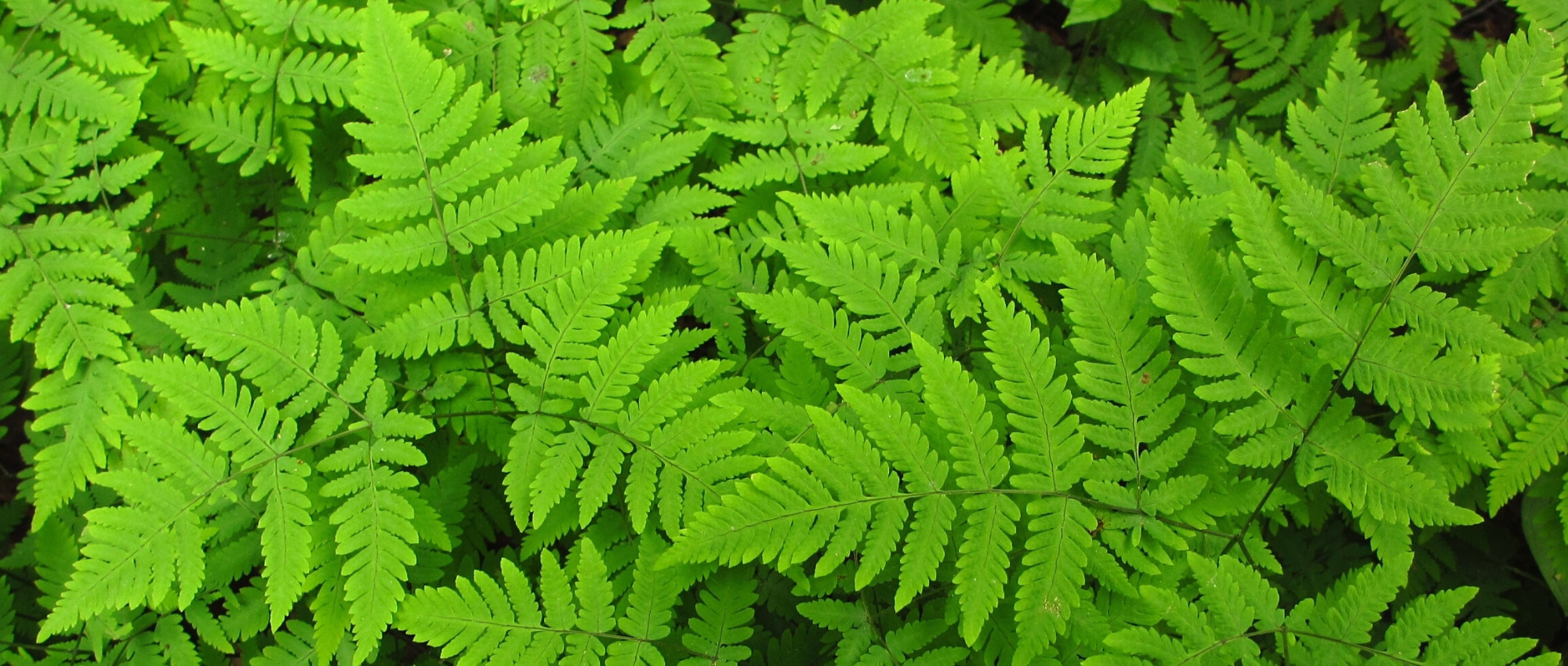
Gymnocarpium: planting, growing, and care
Contents
Gymnocarpium in a nutshell
- Gymnocarpium is a lovely little groundcover fern with deciduous foliage
- It has triangular and very light fronds, finely divided
- Light green in colour, its fronds bring a lot of brightness to the understory!
- Gymnocarpium can form large carpets in the understory
- It thrives in cool to moist, acidic soil (Gymnocarpium dryopteris) or calcareous soil (G. robertianum)
- Completely hardy, it requires little maintenance
A word from our expert
Gymnocarpium are lovely ferns native to the temperate and cold regions of the Northern Hemisphere (Europe, Asia, and North America). They can be found in the wild in France, primarily in mountainous areas. They spread through their creeping rootstocks to form large carpets of triangular, finely divided fronds in a beautiful light green colour. They are ideal for bringing brightness to shaded areas. These are deciduous ferns that disappear in winter. Discover the Gymnocarpium dryopteris, which grows in shaded areas on acidic soil and gradually forms a dense, spreading groundcover, perfect for limiting the growth of adventive plants. The Gymnocarpium robertianum, on the other hand, is another interesting species to grow, thriving in shaded limestone rockeries.
Gymnocarpium have a beautiful, very natural and wild style. They will integrate wonderfully into a woodland garden, for example, alongside hostas, Solomon’s seals, Brunneras, Geranium nodosum, and other ferns. The Gymnocarpium robertianum will easily find its place in a shaded rockery. Gymnocarpium require little attention and are rarely affected by diseases or pests, but they do need the soil to remain fairly moist. Discover all our tips for successfully growing them in this guide.
Botany
Botanical data
- Latin name Gymnocarpium sp.
- Family Cystopteridaceae
- Common name Oak fern, oak polypody, gymnocarp, common curranie
- Flowering none
- Height between 15 and 40 cm
- Exposure shade or partial shade
- Soil type humus-bearing, moist, acidic (G. dryopteris) or calcareous (G. robertianum)
- Hardiness excellent, between –25 and –30 °C
Gymnocarpium comprises 9 species of lovely small carpeting ferns, rhizomatous, with light and finely divided fronds, deciduous. They grow in temperate and cold regions of the Northern Hemisphere: found in Northern and Central Europe, temperate Asia, North America, and as far as Greenland.
In France, one can notably find Gymnocarpium dryopteris and Gymnocarpium robertianum. These are montane ferns, primarily found in altitude forests, although they can also be encountered in lowland areas (more rarely). They mainly grow above 500 m altitude, and up to 2,300 metres. This explains why these ferns are very hardy: they can withstand temperatures dropping to –25, even –30 °C. Gymnocarpium dryopteris grows on siliceous, acidic terrain, in forest soil, while Gymnocarpium robertianum is found on calcareous scree, rocky areas, cliffs, and old walls.
Gymnocarpium belongs to the large group of ferns and horsetails, the Pteridophyta. These are primitive, very ancient plants that existed long before flowering plants appeared. Ferns, along with mosses, are among the first plants to have emerged from water to occupy dry land. They retain a very primitive organisation in terms of their tissues and mode of reproduction, remaining dependent on water for reproduction.
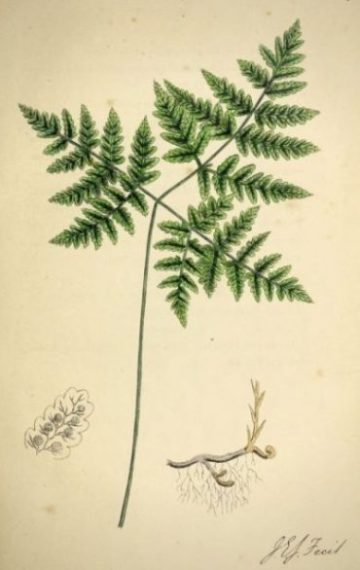
Gymnocarpium dryopteris: Botanical illustration
Among ferns, Gymnocarpium is related to the botanical family of Cystopteris (another lovely small montane fern found in France), the Cystopteridaceae. This small family comprises only three genera and 41 species of ferns.
The name Gymnocarpium comes from the Greek gymnos: “naked”, and karpos: “fruit”, referring to the absence of an indusium (a small membrane that usually covers the sori in ferns). The name dryopteris comes from the Greek drus: “oak”, and pteris: “fern”. It is commonly referred to in French as the Oak Fern. However, it does not specifically grow near oaks, but is rather found in beech and conifer undergrowth.
Gymnocarpium is a groundcover fern, gradually spreading through its creeping and ramified rhizome. Generally, it measures 20-30 cm high (up to 40 cm at most). Gymnocarpium dryopteris can form dense and extensive carpets.
The fronds are directly attached to the underground rhizome by their petiole. Thus, instead of forming a tuft or crown like other ferns (for example, Matteuccia or Dryopteris, where all fronds emerge from the same point), the fronds appear to emerge individually from the ground.
As with other ferns, the fronds first appear as spiralled croziers, then the lamina gradually unfolds.
The fronds are borne on a long, slender petiole, dark brown at the base, and longer than the lamina. The junction point between the top of the petiole and the base of the lamina is jointed, allowing the fronds to orient themselves according to light. They are generally held horizontally.
Gymnocarpium is appreciated for its beautifully light green, finely divided fronds, giving them a delicate and airy appearance. With its fresh and bright hue, this fern is perfect for bringing a bit of light under the canopy of large trees. The fronds have a very fine and light texture. They are two to three times divided (bi- to tripinnatisect) and have a characteristic isosceles triangle shape. This is due to the two basal pinnae, which are almost as large as the rest of the frond. The fronds are glabrous, hairless. They measure between 10 and 20 cm long and wide.
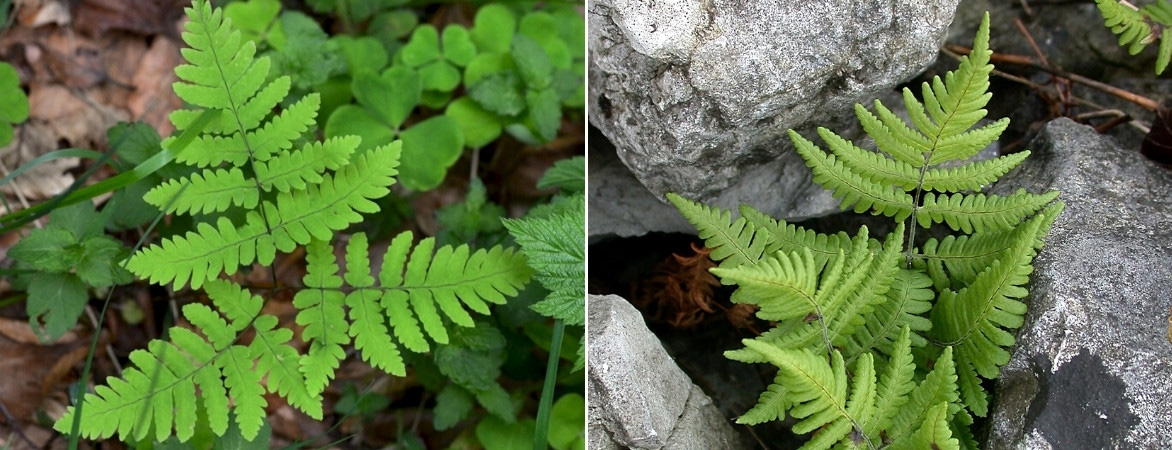
The fronds of Gymnocarpium dryopteris and Gymnocarpium robertianum (photos: Radio Tonreg / Len Worthington)
The fronds of Gymnocarpium are deciduous. This fern unfurls its fronds in spring, produces spores in summer, then the fronds dry out in autumn… and will reappear the following spring.
The two species Gymnocarpium robertianum and G. dryopteris are very similar, and can easily be confused, but the former is distinguished by slightly pubescent petioles and rachises, which are a bit thicker, and more finely divided, elongated fronds compared to G. dryopteris. The petioles and rachises of the latter are black and rather slender, very fine.
Like other ferns, Gymnocarpium does not produce flowers or seeds, but reproduces by releasing spores, fine as dust. They are produced on the underside of the fronds in summer (between July and September). They are contained in small sacs (sporangia), grouped in rounded clusters (sori). Unlike other ferns, they are not covered by an indusium (protective membrane). These very light spores are released when they mature and are dispersed by the wind. They will fall to the ground and germinate upon contact with water, giving rise to small intermediate organisms resembling moss: the prothalli. These carry the sexual organs. Water will allow fertilization, leading to the birth of new young plants of Gymnocarpium in the form we know.

The spores of Gymnocarpium are contained in small sacs called sporangia, which are grouped in circular clusters on the underside of the fronds. In the left photo, those of Gymnocarpium robertianum, not yet mature, and in the right photo, those of Gymnocarpium dryopteris. Their black hue indicates they are mature and ready to release spores. (photos: Krzysztof Ziarnek / Walter Siegmund)
Read also
Ferns: growing and plantingThe main varieties
[product sku=”85362″ blog_description=”The oak polypody is a lovely groundcover fern with delicate, very fine, triangular fronds of a beautiful light green colour. Over time, it can form large carpets in woodland areas. It has been awarded the Award of Garden Merit by the Royal Horticultural Society (RHS).” template=”listing1″ /]
Discover other Gymnocarpium
View all →Available in 1 sizes
Planting
Where to plant?
Like most ferns, Gymnocarpium are understorey plants: they thrive in shade (even dense shade). They require soil that remains cool and appreciate good humus-bearing, light soil, such as that found in woodlands. Don’t hesitate to add well-decomposed compost or manure to enrich the soil.
Be cautious about pH, as Gymnocarpium dryopteris prefers acidic soils, while Gymnocarpium robertianum has a preference for limestone! The former grows in humus-bearing, cool soil, while Gymnocarpium robertianum is found in the wild among rocks, in scree or rubble areas, or on old walls. Thus, it particularly enjoys a cool, shaded rockery.
As it is a small fern, we recommend planting Gymnocarpium in groups to achieve a more immediate visual impact. It will form a denser, spreading carpet more quickly if you install several plants together.
When to plant?
Plant Gymnocarpium in spring, around April, or in autumn, in September-October.
How to plant?
- Start by placing the pot in a basin filled with water to rehydrate the root ball.
- Dig a planting hole about three times the size of the root ball.
- Place a bit of soil mixed with well-decomposed compost at the bottom.
- Gently remove the Gymnocarpium from its pot and place it in the centre.
- Fill in with soil all around.
- Gently press down with the palm of your hand to ensure good contact between the soil and the roots.
- Water generously.
- You may add a layer of mulch (dead leaves, dried fronds, RCW…).
For more information, feel free to consult our guide on planting ferns
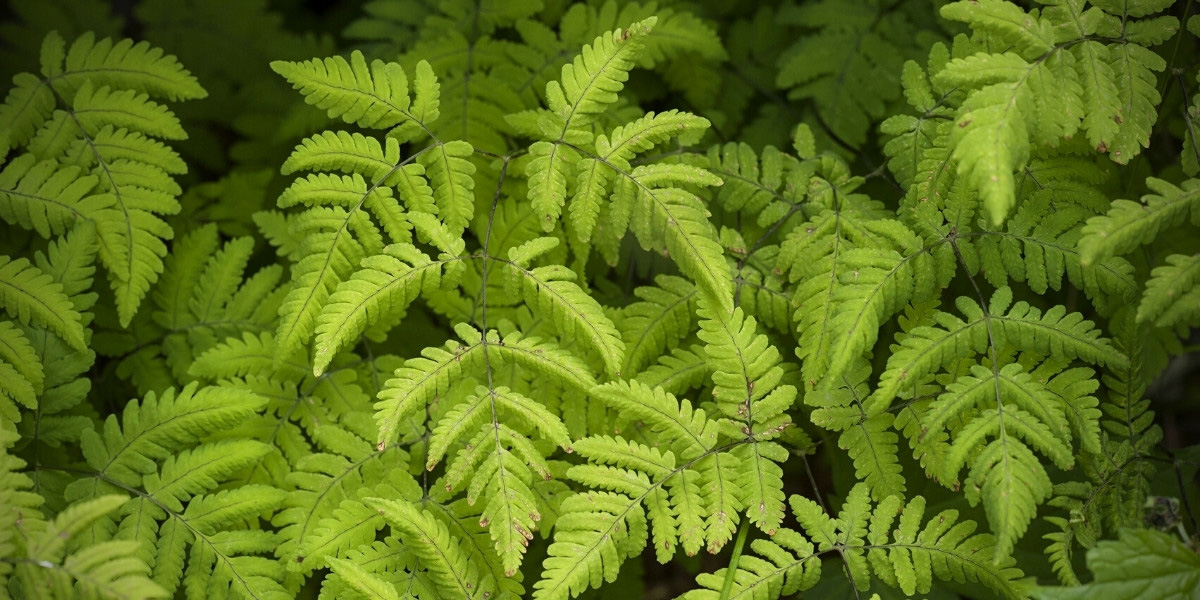
Gymnocarpium dryopteris (photo Adobe Stock)
Read also
Ferns: how to choose them?Care
Like other ferns, Gymnocarpium requires little maintenance once established and is rarely affected by diseases or pests. Ensure that the soil remains moist, especially during the first few years, by watering if necessary. For Gymnocarpium dryopteris, it is better to use rainwater, as tap water may be too hard for it.
Feel free to apply a mulch of fallen leaves, dried fronds, or RCW (ramial chipped wood) around the base of the Gymnocarpium. In addition to keeping the soil moist for longer, this mulch will limit the growth of adventive plants and gradually enrich the soil as it decomposes. For more tips, check out our dedicated mulching guide.
Similarly, as Gymnocarpium is deciduous, you can cut back the dried fronds in autumn.
Multiplication
Sowing
It is possible to propagate Gymnocarpium by collecting the spores that detach from the undersides of the fronds and sowing them. Gymnocarpium produces spores in summer, between July and September.
- Start by mixing potting soil and sand, then sieve it to obtain a fine substrate.
- Place it in a transparent plastic or glass container.
- Water to moisten the substrate.
- We recommend microwaving it (for about 10 minutes) to sterilise it. This will prevent the appearance of mosses and fungi.
- Wait for the substrate to cool, then sow the spores by scattering them on the surface. Be careful, unlike a traditional sowing, do not cover them with potting soil!
- Next, place a transparent lid on the container. This will help keep the medium moist and sterile.
- Then place your sowing in a bright location, avoiding direct sunlight, ideally at a temperature of 15 to 20 °C.
Division
As Gymnocarpium spreads through its creeping rootstocks, once it is well established, it can be propagated by dividing its rootstocks in spring. This technique is much easier and quicker than sowing spores.
- Choose a well-developed clump of Gymnocarpium;
- Gently dig it up, making sure to dig wide enough not to damage the rootstock and roots;
- Remove excess soil to make the rootstock clearly visible;
- Cut it into several sections, each with a few fronds and roots;
- Replant each part in soil or pots;
- Water generously.
Pairing ideas
With its very delicate fronds, Gymnocarpium dryopteris will easily find its place in a natural woodland garden. It will form large carpets in the shade of trees, alongside, for example, sweet woodruff. You can easily pair it with hostas, brunneras, Solomon’s seal, Geranium nodosum, astrances… as well as other ferns. Also consider the delicate flowering of Tricyrtis!
Gymnocarpium dryopteris will wonderfully accompany ericaceous plants, which thrive like it in acidic soil. Think, for example, of rhododendrons and azaleas, Japanese maples, Andromeda polifolia, heathers, Skimmia japonica… Also integrate other ferns, such as Cyrtomiums or Blechnum spicant, which has long dark green fronds.
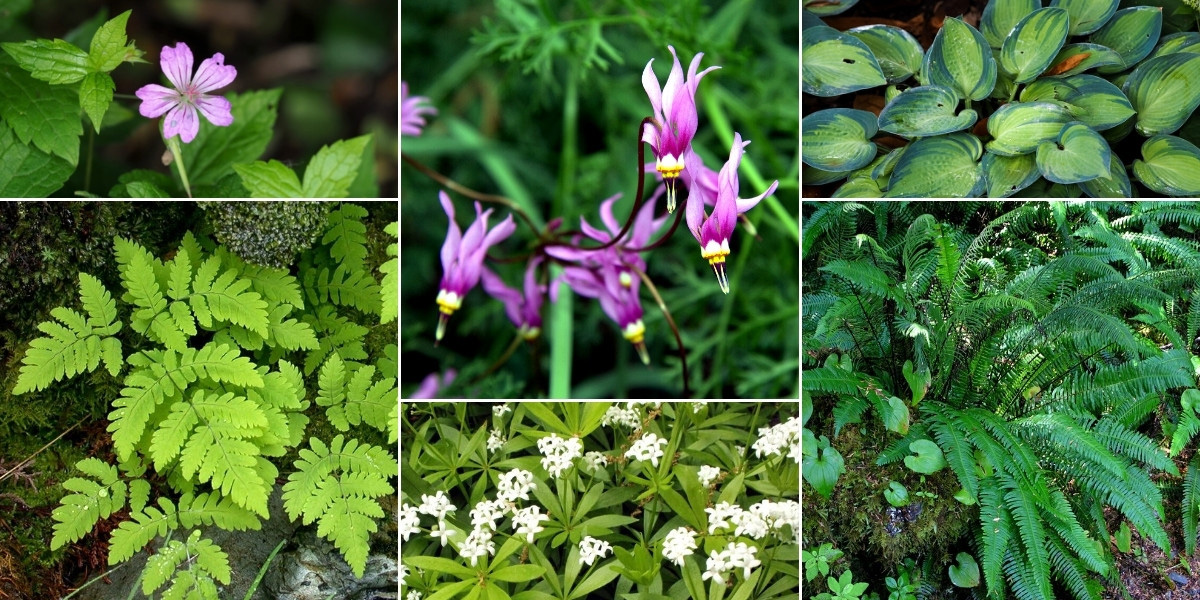
Gymnocarpium integrates easily into a very natural woodland garden style! Geranium nodosum, Dodecatheon conjugens (photo C.T. Johansson), Hosta ‘June’, Gymnocarpium dryopteris (photo Len Worthington), Galium odoratum (photo Jack W.Pearce) and Blechnum spicant (photo brewbooks)
Gymnocarpium robertianum, on the other hand, will be perfect in a cool, shaded rockery. You can pair it, for example, with ferns such as Coniogramme emeiensis, Cyrtomium falcatum, polypody or maidenhair fern. Also consider Tiarella, heucheras, Ajuga reptans, Lamiums, hostas, and saxifrages. Discover our sheet “10 plants to create a shady rockery”.
And for more pairing ideas with Gymnocarpium, feel free to check our sheet: “Ferns: 9 easy association ideas to succeed!”
Useful resources
- Discover all our articles on ferns
- To pair with Gymnocarpium, our entire range of shade plants
- Subscribe!
- Contents































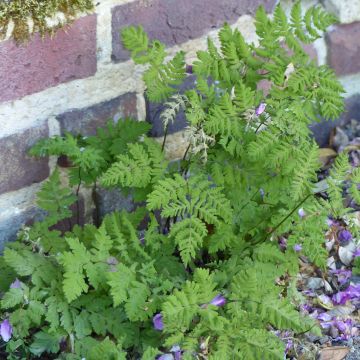
Comments